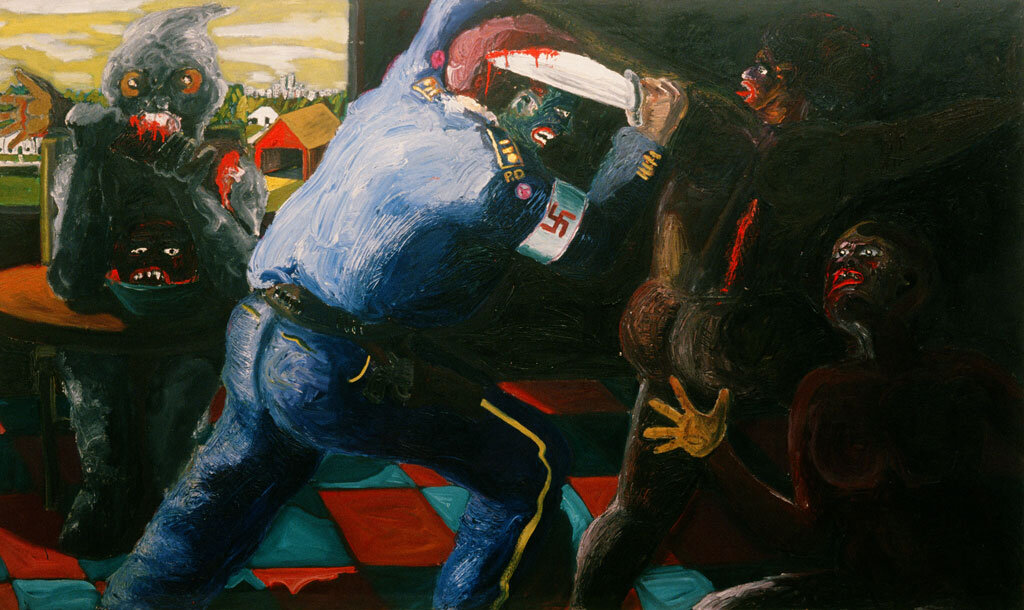VIEWING ROOM
Mike Henderson:
The Early Years
Sales Inquiries: Alexandra Michaels, Sales Associate
alexandra@hainesgallery.com
Press Inquiries: Irene Fung, Gallery Manager
irene@hainesgallery.com
Protest Paintings
In 1965, celebrated artist and blues musician Mike Henderson moved from a rural farming community in the Midwest to attend the San Francisco Art Institute. Galvanized by an atmosphere of protest and possibility, the young artist set to work producing a breakthrough series of large-scale, figurative paintings—many of them overtly political. “The Vietnam War was going on, and the Civil Rights Movement, and the Haight. So I did these huge protest paintings of Blacks fighting back against the system,” Henderson recalls.
Mike Henderson
The Scream, 1966
Oil on canvas
Collection of the Fine Arts Museum of San Francisco
Works from this series were included in two important exhibitions at the Whitney Museum of American Art: Human Concern / Personal Torment: The Grotesque in American Art (1969) and Contemporary Black Artists in America (1971). These shows brought Henderson’s early works into dialogue with a range of artists concerned with violence and social justice, from Leon Golub to Robert Colescott. Now, nearly 50 years later, Henderson’s Protest Paintings and early abstract works are finding renewed relevance.
Mike Henderson
Non Violence, 1968
Oil on canvas
Mike Henderson
Singers, c. 1966
Oil on canvas
Mike Henderson
Crazy Dreams, c. 1966
Oil on canvas
Writing about Contemporary Black Artists in America, art historian Susan E. Cahan observes: “One of the most interesting juxtapositions in the exhibition was a pairing of works by Mike Henderson, The Smile (1968) and Revolution (1970). The earlier work is a gestural painting of a smiling face. The later piece is abstract, but suggestive of a disc, target, or the concentric circles of an eye. The juxtaposition marks a pivotal change in the artist’s style.”
Space Modules
Henderson received his MFA degree from the San Francisco Art Institute in 1970, a year that marked a dramatic change in the form and content of his work. Like many artists searching for new modes of expression following the tumult of the previous decade, Henderson left behind his explicitly political paintings of the 1960s to begin experimenting with abstraction.
The large, abstract mixed-media pieces that followed recall Salvador Dalí’s surrealist dreamscapes and the works of Yves Tanguy. Writing in the journal Black Camera, Mark Hain and Michael T. Martin note: “Henderson refers to the works from this period as ‘space modules.’ Amid the colors and shapes making up what seem to be alien landscapes, fragments almost coalesce into recognizable images—a face, a figure, an animal, musical symbols, letters—but then retreat back into their compelling mysteriousness.”
Mike Henderson
Water Boy, 1978
Acrylic and mixed media on canvas
Collection of The Studio Museum in Harlem, New York
About the Artist
Photo: Robert Divers Herrick
Mike Henderson
b. 1943, Marshall, MO
Lives and works in the San Francisco Bay Area, CA
Mike Henderson received his MFA and BFA from the San Francisco Art Institute. His work has been exhibited at institutions that include the Whitney Museum of American Art, NY; Museum of Modern Art, NY; San Francisco Museum of Modern Art; de Young Museum, San Francisco; and the School of the Art Institute of Chicago. He was the subject of a recent solo exhibition at the San Francisco Art Institute (2019) and was included in Soul of a Nation: Art in the Age of Black Power 1963-1983 at the de Young Museum (2019-2020). Mike Henderson, Before the Fire, 1965-1985, a major survey exhibition curated by Dan Nadel, is scheduled to open at the Jan Shrem and Maria Manetti Shrem Museum of Art at UC Davis in 2022. He has received a Guggenheim Fellowship (1973), two National Endowment for the Arts Grants (1978, 1989), and the Artadia Award (2019).













